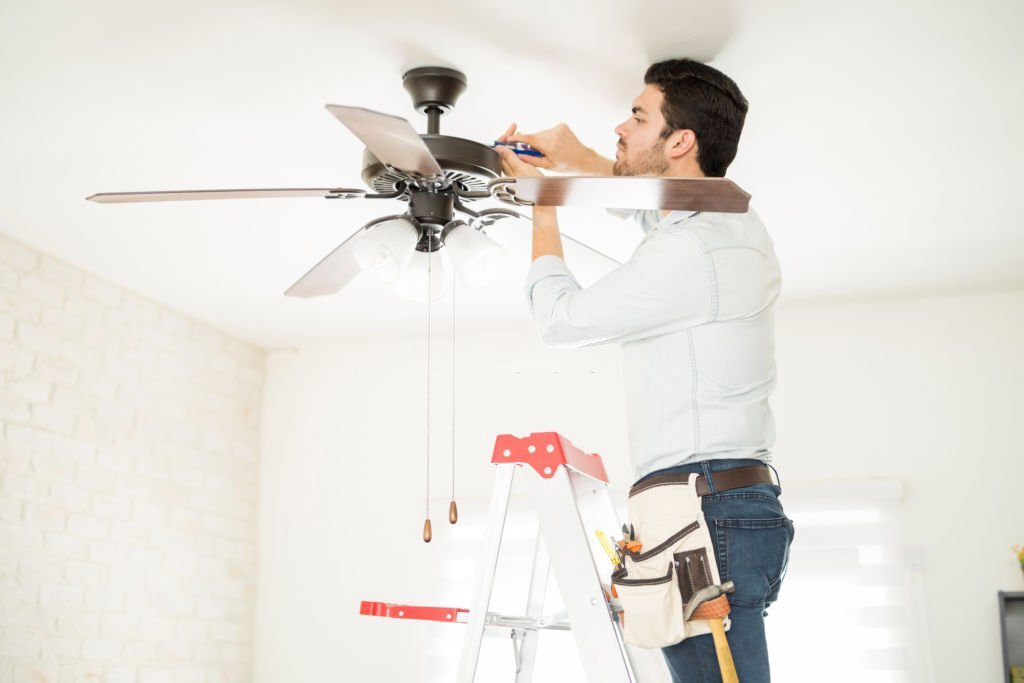
The appearance and comfort of your house may be greatly enhanced by installing a contemporary ceiling fan with lights and remote control. Installing ceiling fans on your own might help you save money if you want them for bedrooms. However, there’s a chance that you’ll encounter some issues along the way. However, if it’s not done correctly, it can wind up costing you more in repairs and energy costs.
All you have to do is go through the top features that are currently offered in the same manner that you plan to. However, you must exercise caution to carry out the operation flawlessly to prevent errors. Some of the frequent errors individuals make while installing ceiling fans are listed below.
Inaccurately Measuring the Ceiling Slopes
Without the necessary experience, it is common to make this error while installing a ceiling fan. Maintaining a 2-foot level only against the ceiling is a healthy habit. Determine the vertical distance between them starting from there. Divide the result by 2 once you get it. By doing this, you gain control over the 3/12 slope or the 12″ horizontal run. In the summer, ceiling fans move chilly air, while in the winter, they blow warm air. Because of this, it’s crucial to put the fans in the proper location.
Not Removing the Existing Electrical Box Before Installing the Fan
Locate the precise location where the ceiling fan has to be installed to make sure the ceiling is ideal. If power supply accessories like an electric box are not readily available, you should think about the greatest alternatives that are available to get the most adaptable outcomes. All you have to do is take out the electrical box from the ceiling before hanging the fan following your precise requirements.
Not Putting in A New Fan Hanger Box and Bracket
When mounting a fan on a low ceiling, it is crucial to install a new fan hanging bracket and box. Feed the current electric line through a cable clamp just at top of the brand-new metallic box to install it. The box should then be clamped by sliding it over the screws and tightening the nuts. After that, use a nut driver to shaft it. Finally, tighten the grounding screw by wrapping the grounding wire around it three-quarters of the way. Never forget to take out the old plastic or metal electrical box. Install a “fan brace” that holds the ceiling fans after that.
Completely Ignoring Down-Rod Size
You must choose the appropriate down rod size when buying a ceiling fan. The performance of the fan might be negatively impacted by overlooking the down rod size. The down rod’s diameter affects how much air the fan delivers. Its cooling capability is thus impacted by this. The minimum range between both the ceiling and the sweep of the blades should be 9 to 10 inches to allow for optimal airflow. Choosing the proper down rod size is crucial for safety reasons as well. Always hang a ceiling fan 7 to 7.5 feet above the ground. It should be around 8 to 8.5 feet for rooms with higher ceilings.
Placing A Ceiling Fan Too Near a Piece of Furniture
A ceiling fan’s capacity to provide a smoother airflow, especially when installed in a room with a high ceiling, is one of its main advantages over an air conditioner. In contrast to the more acute chill, you might experience while sitting next to an air conditioner, the air dances around the space. But not many people are aware that positioning a fan too close to furniture pieces poses several dangers. However, more generally, positioning a ceiling fan next to furniture might affect how turbulent the airflow is. This suggests that some pieces of furniture could be preventing the air from circulating more comfortably. Therefore, you could think about shifting the furniture if you don’t like the ventilation in your room.
Switching The Power Back on During Installation
Turn off the electricity in that room until the procedure is finished. When hooking the fan into your home’s main electrical system for installation, you run the risk of getting an unpleasant shock if any of the wires are live. When using electrical systems, accidental shocks are among the most significant and hazardous errors you can make, therefore you must exercise extreme caution.
Incorrect Wattage Ceiling Fan
You are aware that one of the significant factors in power costs is wattage. If you would like to keep your room cool throughout the summer, you should select a ceiling fan with a suitable wattage. You may spend a lot of money each month on ceiling fan maintenance and repair featuring high wattages.
Ignoring The Given Manual
People frequently make the error of starting the installation procedure right away even without reading the documentation. And although while installing a fan is not very difficult, we nevertheless advise that you read the manual once getting started. If the fan you purchased includes an online installation video, you may also view it to learn how to install it. There are a variety of installation videos available for the numerous ceiling fans that the business offers.
If You Don’t Know What You’re Doing, Avoid DIY Projects
Even if installing a ceiling fan is simple, it is still advisable to consult a professional if you are unsure of your installation techniques. A professional knows exactly how to connect everything, where to position the power line and how high off the ceiling you should hang the fan.